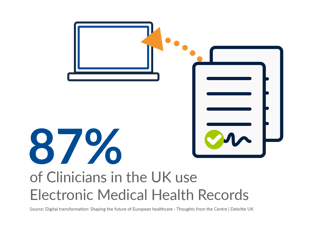Part 1: Care in a Digital Age
Introduction to Data-Driven Healthcare
In this two-part blog series, Don McIntyre, Digital Consultant for Chess, reviews the Scottish Government health and care strategy 'Enabling, Connecting and Empowering: Care in a digital age'. Part one covers:
- Jump to Shifting the Balance of Care >
- Jump to The Citizen as the Point of Integration >
- Jump to What is a Personal Data Store? (PDS) >
- Jump to The Internet of Healthcare Things >
- Jump to The Promise of Artificial Intelligence (AI) >
- Jump to Book your Free consultation>
In October 2021, The Scottish Government republished its health and care strategy Enabling, Connecting and Empowering: Care in a digital age. When the document was first published in 2018, there was no indication of what was to come and the demands that would be placed on all aspects of the health and care service. However, the vision set out in the document remains entirely relevant. Organisations across the country used digital technologies to work at great speed and under incredible pressure, both in responding to Covid-19 and sustaining essential health and care services.
The document outlines three goals, which are close to those identified by the other UK Governments:
Aim 1: Citizens have access to, and greater control over, their own health and care data – as well as access to the digital information, tools and services they need to help maintain and improve their health and wellbeing.
Aim 2: Health and care services are built on people-centred, safe, secure and ethical digital foundations which allow staff to record, access and share relevant information across the health and care system and feel confident in their use of digital technology to improve the delivery of care.
Aim 3: Health and care planners, researchers and innovators have secure access to the data they need to increase the efficiency of our health and care systems and develop new and improved ways of working.
The same document identified several digital-focused priorities to support these aims, including Digital Access, Digital Skills and Leadership and Digital Futures. An additional priority, and the focus of this blog, is the data-driven services and insight, the goal of which is described as 'harnessing data to the benefit of citizens, services, and innovation'.
The topic of data and how it can be used more effectively has featured prominently during engagements with clients such as Cambridge Community Services NHS Trust and Just One Norfolk. These discussions motivated this two-part blog series which will examine aspects of why, how and what data-driven healthcare provision might evolve to support the needs of citizens, caregivers and the wider healthcare community.
Shifting the Balance of Care
There is a recognition within health and care of the need to 'shift the balance of care' from hospital-based treatment to prevention and community focused self-management. This will save the NHS money and allow clinical staff to use their time more efficiently. It will also empower citizens, caregivers and communities to manage their own care more effectively. With respect to digital technologies, this may involve the combination of AI and wearables to enable the detection of conditions the patient did not even know they had, facilitating proactive, preventative healthcare. The earlier issues are detected, the more likely they can be managed and treated, resulting in a better quality of life for the patient and a reduction in healthcare costs.

The Citizen as the Point of Integration
In the 'preferrable future', the individual has control over how the data generated about them and by them is shared across a digital ecosystem of services, including health and care systems, consumer services and even other public systems such as housing and social security. The individual will determine with whom and to what extent information is shared, effectively acting as the point of integration. Central to the functioning of this infrastructure is a way of securely storing data which can be shared via available data exchanges or SSI (Self Sovereign Identity) services. For this to function effectively and safely, there will be the need to store data in personal data stores (PDS).
What is a Personal Data Store? (PDS)
A Personal Data Store supports citizen-controlled, online storage and exchange of personal data and proofs in a safe, secure, and straightforward manner. It allows users to have complete control over their data and reuse it as they move between services. Other platforms or applications can seamlessly integrate with the PDS to access information with citizen consent. The PDS acts as a 'single source of personal truth' to empower the individual and reduce friction, effort, risk, and cost for both citizens and organisations. It does not hold all the data but instead pulls data together from different sources to feel to users like it is a single record.
A PDS can handle standard data or the 'verified attributes'. A version can be stored on a phone if needed, and it can hold the keys described in the SSI model. A PDS can contain a wide range of different types of information and proofs from across all aspects of life. Having access to this online and in one place can be very useful. Similar systems are already commonplace in Fintech, so why not healthcare.

The Building Blocks of Security and Compliance
in UK Healthcare Organisations
The Internet of Healthcare Things
In recent years we have moved beyond the Apple Watch, smart scales, and Fitbit being clever, engaging and fun toys. Instead, you can use smart devices deployed in the home to assist those with chronic diseases and communicate information back to hospitals and caregivers.
In the near future, it will be possible to combine speech recognition and passive scanning of environments to detect falls or other emergencies in a seamless way. All of this inevitable functionality can be delivered through Cloud services which simplify data management, centralisation and security.

What the FUD?! Video Series
IoT Security in UK Healthcare
The Promise of Artificial Intelligence (AI)
AI will have a profound effect on healthcare. It already does. Alongside wearables and devices outlined in the previous section, AI has a vital role in detecting viral infections like SARS-CoV-2. Examples will be wearables like the Oura ring, which can detect issues three days before the onset of symptoms is perceived by a clinician using current methods. Combining wearables' data with intelligent health algorithms and AI can decipher specific, actionable insights for use by healthcare professionals. Harnessing data science and AI for drug development innovation is also a growing field for drug discovery. In simple terms, these is the opportunity for AI to augment human capabilities.
I am not suggesting that 'technology is the easy part' because it's not. The solutions, integration and innovation associated with the necessary transformation in healthcare will require a new generation of talented digital health and care professionals. However, in a world where the citizen becomes the point of integration, the role of the community and care environment will be fundamental and vital in defining how data is captured, employed and shared.
Read part two to learn more about Managing Citizen-Controlled Health Data >
We can help you on your journey and advise on the best approach for your organisation. Contact our expert team and book your FREE technology consultation today.

Speak to a Specialist
You can fill out the form and one of our product specialists will contact you shortly with more information.



About the author
uSkinned
uSkinned, the world’s number one provider of Umbraco CMS themes and starter kits.